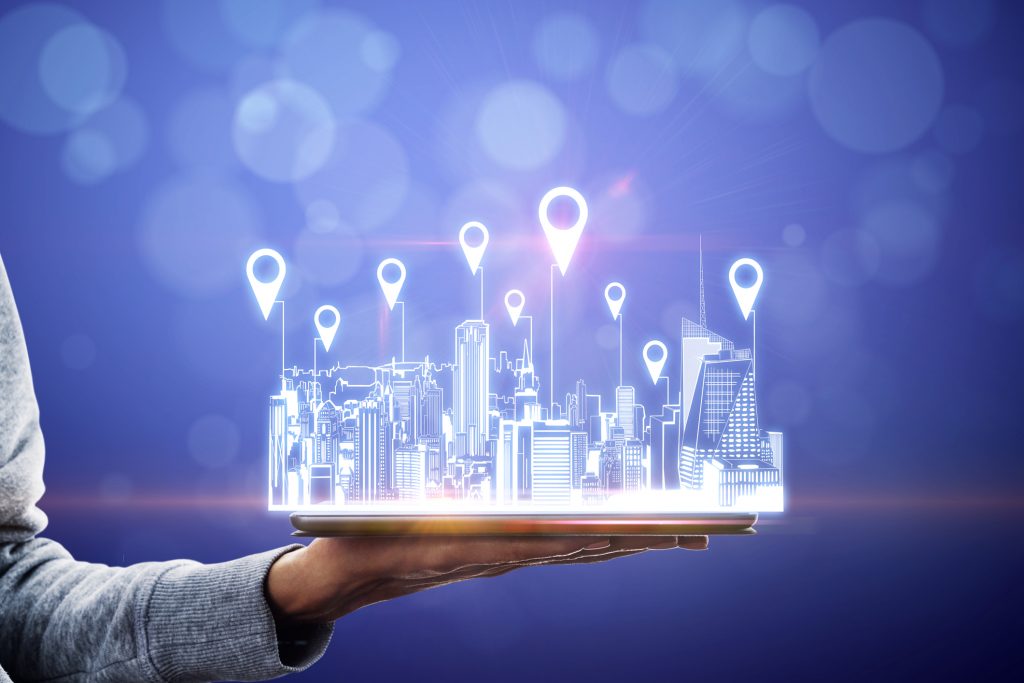
Contrary to popular belief, the first geolocation app was not Pokémon GO, but rather a Palm Computing app called TrafficTouch that delivered real-time traffic alerts to the Palm VII.
Although basic and without GPS (this was back in 1999, after all), the solution proved that geolocation technologies, no matter how rudimentary, could be packaged in a consumer offering to deliver critical and timely information when mobile users need it the most.
Today’s location-based apps are not much different under the hood than the early Palm VII when it comes to geolocation functionality. Regardless of the current geolocation app trends, the same concept applies: the location-based service must determine the user location and deliver a contextualized experience based on its current coordinates.
From this basic premise, a myriad of location-based apps have emerged—from food delivery, patient monitoring, and mental wellness management to location-based chat apps, all available with a tap of the screen.
Geolocation Technologies in 2021
Despite the early demise of Palm and its line of handheld devices, the spirit of location-based apps would re-manifest itself a decade later with the arrival of the iPhone and Android devices. Powered by a thriving app ecosystem and developer base, geolocation technologies in the form of location-based apps were once again in the consumer spotlight, and they’ve been part of the mobile app narrative ever since. In 2021 and beyond, location-based services are standard components of most apps, and there doesn’t seem to be a shortage of use cases for them.
Geolocation apps have also become more mission-critical, as many have now been battle-tested in times of crises. During the last year we’ve seen the emergence of location-based apps for contact tracing, social distancing recommendations, and crowd density reporting in public spaces, to name a few.
Today’s mobile users are inseparable from their devices, and that makes them ideal for continuous geolocation awareness. And because geolocation technology these days relies on several methods for determining the device and its owner’s whereabouts (e.g., GPS, WiFi, cell tower data, Bluetooth), delivering a highly targeted, time-sensitive mobile experience for users in real-time based on their surroundings has never been easier.
Location-based Apps for a Post-Pandemic World
Public health and emergency use cases aside, businesses are still poised to be the greatest benefactors of geolocation technologies. The location-based app market size hit $17.8 billion last year, and it’s projected to surpass $39.2 billion by 2025. As the pandemic restricted mobility and travel, geolocation technology use shifted to industries such as healthcare, life sciences, and public power/utilities.
Games will continue to dominate the space, but mission-critical apps—both non-commercial and revenue-driven—are starting to make their way onto the app download leaderboards.
Some recent, interesting takes on the location-based app include:
On the enterprise front, location-based apps are now being developed for:
Two geolocation technologies in particular are worth noting because they enable and extend the capabilities of location-based services in the previously listed apps: the geofence and beacon.
A geofence (or geofencing) is a location-based service that creates a virtual boundary around a geographic location using a GPS tracking system. Whenever the boundary is breached, an action is triggered on the mobile device. For example, a user may download a location-based app from a prominent retailer to receive promotional updates. Whenever the person drives by that retail location (or any of the franchise locations), an in-app promotional code appears for use at that retail outlet.
Beacons enable businesses to present opportunities based on the geolocation of a consumer’s mobile device. In this case, miniscule devices that emit Bluetooth low energy (BLE) signals are strategically installed in the consumer’s environment. However, instead of using GPS to pinpoint the device’s exact location, the beacon waits for a response from nearby mobile devices with the retailer’s app installed. If the consumer is in close proximity to the transmitting beacon, they will receive a highly contextualized response (as in, “sale on potato chips, just to your right!”).
Security and Privacy
Businesses that want to develop their own location-based apps should be aware of the security and privacy concerns around geolocation technologies and location-based apps. Currently, major challenges exist on the international level regarding privacy regulations (such as GDPR) and industry-specific compliance requirements regarding this use of consumer location data.
As shepherds of such hyper-sensitive user data such as geolocation coordinates (both real-time and historical), companies offering location-based apps need to build and maintain secure apps that are free from vulnerabilities and security gaps.
Designers should also remember that users can (and should be able to) disable geolocation/geotagging with a swipe, and design their apps accordingly. Crucially, they should consider how usable their apps are without location awareness. Developer teams are faced with a unique set of challenges when creating location-based apps.
Software Design Solutions Partners with You for Geolocation App Development
Software Design Solutions has extensive knowledge, experience and skill in geolocation app development, IoT, and cybersecurity. We develop location-based apps that are highly-engaging, contextual to the environment, and unobtrusive to end users.
The success or failure of your geolocation app hinges on creating a balance with this trifecta—something we have years of experience doing for our clients. Contact us today to find out how we can put our knowledge to work for you.


